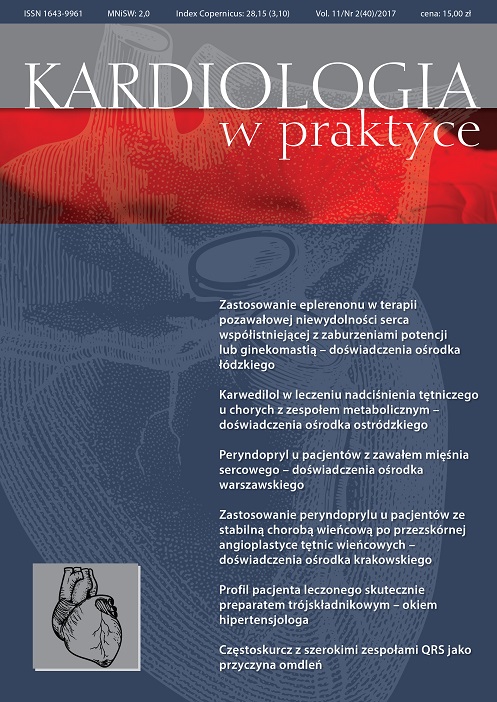Profil pacjenta leczonego skutecznie preparatem trójskładnikowym – okiem hipertensjologa Opis przypadku
##plugins.themes.bootstrap3.article.main##
Abstrakt
W artykule przedstawiono przypadek otyłego chorego ze źle kontrolowanym nadciśnieniem tętniczym. W oparciu o badanie pacjenta i wyniki badań dodatkowych oceniono ryzyko sercowo-naczyniowe. Po wcześniejszych modyfikacjach leków hipotensyjnych włączono trójskładnikowy lek złożony. Osiągnięto dobrą kontrolę ciśnienia tętniczego. Na przykładzie pacjenta przedstawiono zasady terapii hipotensyjnej, w tym korzyści płynące z leczenia lekami złożonymi. Omówiono również wybór zawartych w leku złożonym składników: peryndoprylu, indapamidu i amlodypiny.
Pobrania
##plugins.themes.bootstrap3.article.details##

Utwór dostępny jest na licencji Creative Commons Uznanie autorstwa – Użycie niekomercyjne 4.0 Międzynarodowe.
Copyright: © Medical Education sp. z o.o. This is an Open Access article distributed under the terms of the Attribution-NonCommercial 4.0 International (CC BY-NC 4.0). License (https://creativecommons.org/licenses/by-nc/4.0/), allowing third parties to copy and redistribute the material in any medium or format and to remix, transform, and build upon the material, provided the original work is properly cited and states its license.
Address reprint requests to: Medical Education, Marcin Kuźma (marcin.kuzma@mededu.pl)
Bibliografia
2. Conlin P.R., Gerth W.C., Fox J. et al.: Persistence to antihypertensive drug classes throughout four years. Clin. Ther. 2001; 23: 1999-2010.
3. Dahlöf B., Sever P.S., Poulter N.R. et al.; ASCOT Investigators: Prevention of cardiovascular events with an antihypertensive regimen of amlodipine adding perindopril as required versus atenolol adding bendroflumethiazide as required, in the Anglo-Scandinavian Cardiac Outcomes Trial-Blood Pressure Lowering Arm (ASCOT-BPLA): a multicentre randomized controlled trial. Lancet 2005; 366: 895-906.
4. Dezii CM.: A retrospective study of persistence with single pill combination therapy vs. concurrent two-pill therapy in patients with hypertension. Management Care 2000; 9: 2-6.
5. Hansson L., Zanchetti A., Carruthers S.G. et al.: Effects of intensive blood-pressure lowering and low-dose aspirin in patients with hypertension: principal results of the Hypertension Optimal Treatment (HOT) randomized trial. Lancet 1998, 351: 1755-1762.
6. Jamerson K., Weber M.A., Bakris G.L. et al.; ACCOMPLISH Trial Investigators: Benazepril plus amlodipine or hydrochlorothiazide for hypertension in high-risk patients. N. Engl. J. Med. 2008; 359: 2417-2428.
7. Pall D., Szanto I., Szabo Z.: Triple combination therapy in hypertension: the antihypertensive efficacy of treatment with perindopril, amlodipine, and indapamide SR. Clin. Drug Investig. 2014; 34: 701-708.
8. Troth K.; PIANIST Investigators: Antihypertensive efficacy of triple combination perindopril/indapamide plus amlodipine in high-risk hypertensives: results of the PIANIST study (Perindopril-Indapamide plus AmlodipiNe in high rISk hypertensive patients). Am. J. Cardiovasc. Drugs 2014; 14: 137-145.
9. Tykarski A., Narkiewicz K., Gaciong Z. et al.: Zasady postępowania w nadciśnieniu tętniczym – 2015 rok. Wytyczne Polskiego Towarzystwa Nadciśnienia Tętniczego. Nadciśnienie Tętnicze w Praktyce 2015; 1: 1-70.
10. Widecka K., Grodzicki T., Narkiewicz K. et al.: Zasady postępowania w nadciśnieniu tętniczym – 2011 rok. Wytyczne Polskiego Towarzystwa Nadciśnienia Tętniczego. Nadciśnienie Tętnicze 2011; 15: 55-82.
11. Wytyczne ESH/ESC dotyczące postępowania w nadciśnieniu tętniczym w 2013 roku. Nadciśnienie Tętnicze 2013; 17(2): 69-168.
